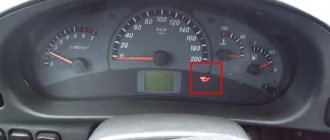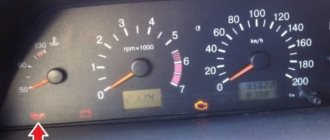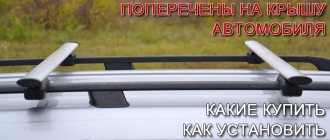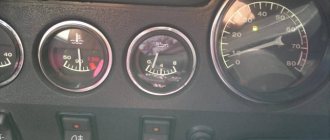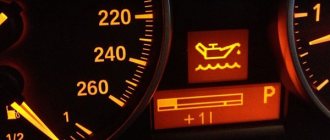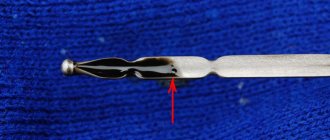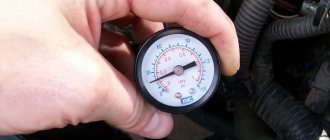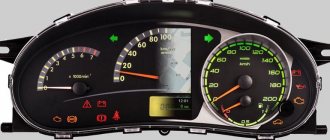What does a non-extinguishing oil pressure light on a car's dashboard mean?
When the indicator lights up on the instrument panel
in the form
of a red oil can
, this first of all means that
the oil pressure in the engine
is insufficient.
In most cases, such a light
appears only for a couple of seconds and does not pose any threat to
the engine
and its main components.
As a rule, a light
in the form of a “
red oil can
” appears when you turn the ignition key and immediately disappears.
In addition, such an indicator
may
light up
when there is a strong roll of the car in a turn, as well as when
the engine is cold started
in winter.
When the indicator
in the form of a “
red oil can
”, you must initially check the presence and level
of engine oil
in
the engine
using
a dipstick
.
If the oil level
is below the minimum permissible value, then in this case such
an indicator
on
the instrument panel
in
red
.
This problem is quite simple to solve - you need to top up the engine oil
to
the optimal
level on
the dipstick
.
If the oil pressure indicator
goes out, then nothing bad has happened; we have eliminated the problem.
In this case, we just got off with a slight fright and just don’t forget to add engine oil to the engine
, and also check it from time to time using
a special dipstick
and level on it.
Let us remind you that the optimal indicator of the engine oil level
in
the engine crankcase
is the mark located in
the center of the dipstick
, between
“
Min
” and “
Max
marks .
In addition, if we ignore
the engine
oil level
red oil can
”
indicator instrument panel
, we risk serious problems with
the engine
and its components in the future.
Note that in some cases, a light
in the form of a “
red oil can
” may
light up
when the old
engine oil
to a new one, and then after the first
start of the engine
,
the indicator
appears for a few seconds and disappears.
If the engine oil
is of high quality and has been replaced correctly,
the indicator
should go out after an average
of 15 seconds
.
If the light does not go out
after this time, then the possible
reason
is poor quality
oil
,
oil filter
or
incorrect replacement
.
In this case, the engine oil
and
filter
must be replaced with new, higher quality ones.
In addition, the replacement
must be made in accordance with the regulations or technical documentation that comes with a particular car.
Problems after oil change
After changing the oil, the light may come on in the following cases:
- low-quality oil was poured;
- a low-quality oil filter is installed;
- pressure relief valve jammed;
- after installing the engine sump (if it was removed), the oil receiver could be close to the bottom of the sump and at high speeds the pump does not have time to pump oil, the light will indicate a lack of pressure;
- the pump has reached the end of its service life and requires repair or replacement.
Oil pressure sensor. Why does it not always accurately signal problems?
On a working engine
at
idle speed
at
750 - 950 rpm
,
oil pressure
should not exceed
0.5 technical atmospheres
per square centimeter.
Different car models are equipped with sensors
that measure
emergency oil pressure
with different response ranges, usually from
0.3 to 0.9 technical atmospheres
per square centimeter.
If a sensor
, which begins to operate at a value of
0.7 technical atmospheres
per square centimeter, then we note that even with an indicator of
0.6 technical atmospheres
per square centimeter, it will turn on
the oil pressure indicator
(
control lamp
) on the dashboard.
As we described above, this indicator
will
signal
that an emergency
drop in the oil pressure level
in
the engine
.
To be sure that the oil pressure sensor
Whether
the engine
is to blame or not for triggering
the indicator
on
dashboard
, it is necessary to increase
the crankshaft speed
to
1050-1100 rpm
at
idle
.
If in this case the control light
goes out, then we can be sure that
the engine oil
in
the engine
is normal.
If, on the contrary, the indicator
lights up continuously in red, then you need to urgently go to a service station to
measure the oil pressure
with a special
gauge
.
This device is connected instead of the oil sensor
and
a control measurement
.
Please note that in order for the oil pressure sensor
did not trigger falsely, it is necessary to
clean
measuring
element and some
engine
output .
To do this, you need to unscrew the pressure sensor
and carefully
clean
all
the oil channels
, since the reason for
false positives
of this measurement element may lie precisely in
blockages
.
Where is the sensor located?
Good to know
On most vehicles, the meter is installed in close proximity to the cylinder head and oil filter.
In order to gain access to the device, you may need to remove the wheel or crawl under the bottom of the car.
Location of the oil pressure sensor
Table: location of DDM on popular car models
| The model of car | Place where the measuring element is located | How to access the controller |
| Lada Kalina (Lada Kalina) | The oil pressure gauge is located on the right rear part of the power unit - in a separate socket of the main cylinder block next to the belt guard. One cable must be connected to the controller. | At the top of the motor. To gain access, the user must remove the plastic cylinder block cover. |
| VAZ 2108/2109/21099 VAZ 2110/2111 (8 valve engine) | The device is located on the right side of the power unit, in a special socket in the cylinder head, next to the belt protective shield. One cable must be connected to it. | Above |
| VAZ 2110/2111 with 16 valve engine | The controller is located at the rear of the power unit on the camshaft block. One cable is connected to the measuring element, next to it there are two bundles of wires enclosed in black insulation. | Above |
| Audi (Audi) - most of the modern models | Near the oil filter device. Depending on the model, there may be an additional meter located on the main cylinder block. One cable is connected to the pressure sensor. | At the top of the engine |
| Chevrolet Lanos (Chevrolet Lanos) | On the oil pump device from the bottom of the power unit. A bundle with cables in a separate insulator must be connected to the sensor. | At the bottom of the engine. The device can only be accessed from under the bottom if the machine is located on a pit or overpass. |
| Ford Transit | In the middle under the front bumper of the car, next to the oil cooler. | |
| Renault Trafic (Renault Traffic) | The engine contains a special device with an oil filter and a heat exchanger. The sensor itself is screwed into the thread on the channel after the oil filter. | Above |
| Mercedes-Benz (Mercedes Benz) - most of the modern models | On these car models, the oil pressure sensor is located on the crankcase on the right side of the central part of the car | At the bottom of the engine. The device can only be accessed from under the bottom if the machine is located on a pit or overpass. |
| Mitsubishi Lancer (Mitsubishi Lancer) | The sensor is located on the rear side, slightly to the right of the motor. The meter is screwed into the power unit next to the lubricant filter. One cable is connected to the sensor. | |
| Nissan X-Trail (Nissan X-Trail) | The device is located in the lower part of the cylinder block, next to the pumping device of the power steering system. | To gain access, the user must remove the right wheel and remove the plastic belt cover. |
| Opel Astra (Opel Astra) | The sensor is located at crankcase level on the right side of the generator set. One cable is connected to the controller. | To change and install a new controller, you need to remove the right front wheel |
| Volkswagen Golf, Jetta (Volkswagen Golf and Jetta) | The measuring device is located at the end of the cylinder head. These cars are equipped with two controllers, the second is designed to record insufficient pressure and is located on the oil filter to the right of the car. | The sensors are located at the top and bottom of the motor, respectively. |
| Volkswagen Passat | The car is equipped with two measuring elements. The first is located on a special bracket upstream of the lubricant filter, the second is located at the outlet of the filter. | Above |
| BMW E39 | The sensor is located on the oil filter cup and is parallel to the power unit. There are two controllers here, one records the temperature, the other records the pressure. | Above |
| Gazelle with power unit ZMZ-405 | The sensor is located on the right side of the main cylinder block, in its upper part. One cable is connected to the meter. | Above |
Reasons for the oil pressure warning light to come on. Possible faults
To be sure of the reasons
the engine oil pressure indicator
lights up , you must first remove
the oil dipstick
and
check
whether
the fluid level
higher than the previous check.
Next, you need to make sure
that
the oil dipstick smell fuel
or anything else foreign, since a situation may arise when
antifreeze
or
gasoline
penetrates the engine .
To determine the presence of gasoline
in
engine oil
, you need to remove
the engine dipstick
and place it in a clean container of water.
If gasoline stains
or
drops of coolant
, then you should urgently contact specialists at a service station, as serious
repairs of the engine
or its components may be required.
If there are no foreign drops
or
fuel stains
, then
this is not the cause of
In case of possible malfunctions with the engine
, which led to the appearance
oil pressure
warning light - these problems are quite easy to notice.
As a rule, engine malfunctions
are accompanied by
increased fuel consumption
, a significant
loss of power
, and quite often
blue (
gray )
or black
begins to come out of the car’s exhaust system muffler .
In addition, we note that if the engine oil indicator
is normal
in
the engine the low pressure warning lamp
does not go out
for quite a long time , for example, when
starting
in cold weather.
Note the fact that when warming up
a car in winter weather at low temperatures outside, this is a completely normal effect, in contrast to summer weather and high temperatures.
How far can you drive if the oil light is on?
The answer to this question also depends on the factors that caused the indicator to light up. In those moments when the lubrication system is working properly, but the oil simply leaves due to leaks or combustion in the cylinders, it is allowed to top up the lubricant and drive until the problem is eliminated. It is important not to confuse this with situations where the filter, pump or its oil intake are faulty. In these cases, even after adding oil, you will not be able to drive, since the engine is not lubricated and any movement, even idling, will damage the engine, increasing the cost of repairs.
If the oil light is on and the cause of the breakdown is unknown, then you should not drive such a car and leave the engine running. It is necessary to bring the car to the repair site to identify and eliminate breakdowns.
Video review: “Engine oil pressure (red oil can). Causes and malfunctions"
In conclusion, we note that during a routine check of the engine oil level on the dipstick, correct and timely replacement of engine consumable parts, it is quite rare for car owners to see an indicator in the form of a “red oil can” light up on the dashboard. In addition, you need to take into account the fact that after parking the vehicle overnight or for a long time, engine oil flows from all channels into the lower crankcase and becomes thick. The next time you start the engine, the oil pump needs a certain amount of time to pump up the working fluid and fill the channels with the engine lines so that optimal pressure is formed. For example, engine oil reaches engine elements such as connecting rod journals or guide channels earlier than the same pressure level sensor. In this connection, rapid wear of the engine and its parts in modern cars is completely excluded. Note that there is no need to worry if the engine oil pressure warning light on the dashboard does not go out within 3-5 seconds. This factor is not dangerous based on the technical documentation of the manufacturer of a particular car.
THANK YOU VERY MUCH FOR YOUR ATTENTION. LEAVE YOUR COMMENTS AND SHARE WITH YOUR FRIENDS. WE ARE WELCOME TO YOUR FEEDBACK AND SUGGESTIONS.
